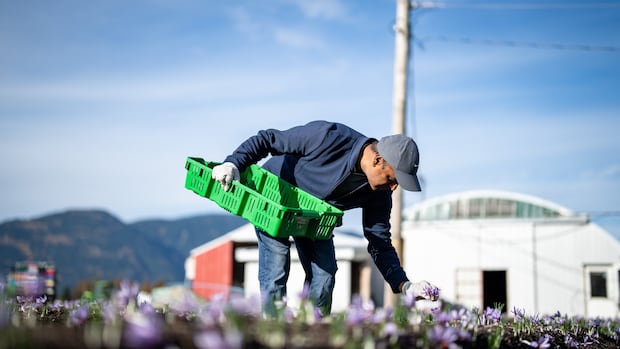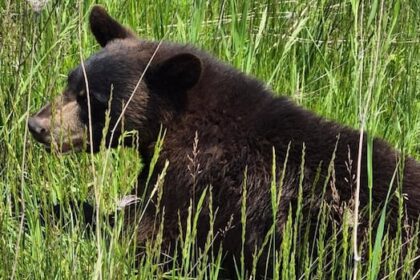British ColumbiaAs golden hour settles over Avtar Dhillon’s farm in Abbotsford, B.C., rows of delicate purple flowers are in full bloom. Inside lies an ancient spice some Canadian farmers are beginning to get excited about. On fields in B.C.’s Fraser Valley and in a garage in Calgary, a handful of growers are innovating with saffronBaneet Braich · CBC News · Posted: Nov 18, 2025 9:00 AM EST | Last Updated: 8 hours agoListen to this articleEstimated 5 minutesThe audio version of this article is generated by text-to-speech, a technology based on artificial intelligence.Avtar Dhillon is pictured on his farm in Abbotsford, B.C., on Oct. 30. (Ethan Cairns/CBC)As golden hour settles over Avtar Dhillon’s farm in Abbotsford, B.C., rows of delicate purple flowers are in full bloom. Inside their petals grow crimson threads of the world’s most expensive spice — saffron. “[It’s] my dream to do something different for Abbotsford,” says Dhillon. The farmer’s labour of love began budding in 2021. He says he was the first to grow the ancient spice on a larger scale in B.C. — and only among a handful in the country. But shortly after his first successful crop, Dhillon was left heartbroken. The B.C. floods in November of that year devastated his farm, leaving nearly 250,000 crocus sativus, commonly known as saffron bulbs, under muddied water. Despite the loss, Dhillon says he remained committed to making Abbotsford the saffron capital of B.C. Avtar Dhillon’s farm is lined with crocus sativus flowers, which contain the world’s most expensive spice. (Ethan Cairns/CBC)Four years later, the dream is flourishing once again. Dhillon has expanded his saffron farm, is working on new technology to make harvesting more efficient and has even inspired other farmers to grow and innovate with the spice, both in Abbotsford and beyond in Alberta and Ontario. “I feel excited,” says Dhillon, walking in late October through his 1.5-acre (0.6-hectare) crop, which is home to more than 500,000 saffron bulbs this year. But as he carefully plucks the flowers for harvest, Dhillon says he’s still facing a major challenge — getting his prized crop insured. It’s security he hopes to see soon for himself and other growers. Plucking the individual saffron threads from out of the flowers is a labour intensive process. (Ethan Cairns/CBC)“They [the provincial government] are not agreeing with me. If anything happens again, I don’t have insurance,” said Dhillon. “Everyone is not comfortable when they [don’t] have insurance.” In a statement, the Ministry of Agriculture said while crop insurance is not currently available for emerging crops such as saffron, coverage can be considered if crops can prove they are “commercially and agronomically viable” in B.C. with enough production and marketing data. It also noted emerging crop growers are eligible to participate in AgriStability, a program that protects farmers from income declines due to things like poor weather and market conditions.WATCH | These farmers are growing saffron on Canadian soil:Saffron is the world’s most expensive spice. Here’s how it’s being grown in CanadaSaffron is known as the world’s most expensive spice per gram. And what was once a budding dream of growing the precious spice in Canada’s cold climate is blooming for more growers in Abbotsford, B.C., and beyond. CBC’s Baneet Braich takes us behind the latest challenges in growing saffron, and the creative solutions to make it work. The ministry said it is aware of a few farmers growing saffron but said to its knowledge none are at the large commercial stage yet. Breaking ground on new innovation Dhillon’s wife, father and sister-in-law gather around a table carefully hand-picking the threads of saffron from the freshly harvested flowers. For them, the hours of effort each day are worth it — a single gram of their saffron sells for $50, Dhillon says.To make the labour intensive process more efficient, Dhillon has hired more staff and teamed up with a designer to build equipment to plant the bulbs and harvest the spice. Dhillon’s wife, father and sister-in-law pluck saffron threads from their flowers. (Ethan Cairns/CBC)Dhillon is inspiring more growers who have sourced bulbs from his farm to research and experiment with saffron. At Charanjit Singh’s farm in Abbotsford, scientists from Canadian Invitro Technologies are working away in a lab growing saffron plants in glass jars. As part of the work, the scientists scrape off plant tissue, put it into a special nutrient rich formula called media and grow saffron and other plants in controlled conditions.Scientist Baljit Singh Gill says each saffron plant can multiply up to three times in the lab, after every six to eight weeks. The young plants are then moved to a propagation greenhouse to strengthen their roots. Once they produce bulbs, they can be planted inside or outdoors. Inside the lab at Canadian Invitro Technologies in Abbotsford, where plants are being grown using tissue culture technology. (Baneet Braich/CBC)“We select plants from the field with good traits, with good qualities … and then we can multiply it,” explained Gill. Their goal is for Canada to produce its own saffron bulbs, free from disease and pests, instead of relying on imports. “I’m getting more experience with my pots and tissue culture techniques so hopefully it’ll grow good. I’m excited to do it,” said Singh.Charanjit Singh and scientist Baljit Singh Gill show how saffron is able to grow from tissue culture in a nutrient-rich formula called media. (Baneet Braich/ CBC )Saffron in a box And beyond B.C.’s Fraser Valley, a Calgary man is growing saffron as a hobby in his garage.Vikash Sangwan, an entrepreneur and engineer, has built a prototype called Saffron Box, which uses AI technology to provide the right conditions for the saffron bulbs to grow indoors. “Who will not want it right? To grow red gold,” says Sangwan. Vikash Sangwan, shows his hobby prototype Saffron Box, which uses AI technology to help grow saffron indoors. (Monty Kruger/CBC)Sangwan is able to monitor factors including carbon dioxide, light and humidity all from his phone by using a third-party app. He hopes to see more Canadians benefit from the spice and for the country to be a major supplier of saffron. “It’s for Canadian families,” says Sangwan. “It’s a grand, grand opportunity.” Sangwan says he can control the conditions in his Saffron Box prototype from an app on his phone. (Monty Kruger/CBC)The ongoing saffron innovation shows how more Canadians are exploring the potential of alternative crops, says Lenore Newman, director of the food and agriculture institute at the University of the Fraser Valley. “All of these things together can really diversify our industry, make sure we’re using our [Agricultural Land Reserve] to the maximum and really growing agriculture to help support Canada’s economy and our sovereignty,” she said. Back in Abbotsford, as the sun sets in the Sumas Prairie, Avtar’s family works away with weeks of another harvest of red gold — saffron — still on the horizon.Dhillon says a single gram of saffron can sell for $50. (Ethan Cairns/CBC)ABOUT THE AUTHORBaneet Braich is a journalist with CBC News. Connect with her at baneet.braich@cbc.ca or on Twitter at @Baneet_BraichBaneet_Braich
These farmers have a dream for the worlds most expensive spice, and it’s rooted in Canadian soil











